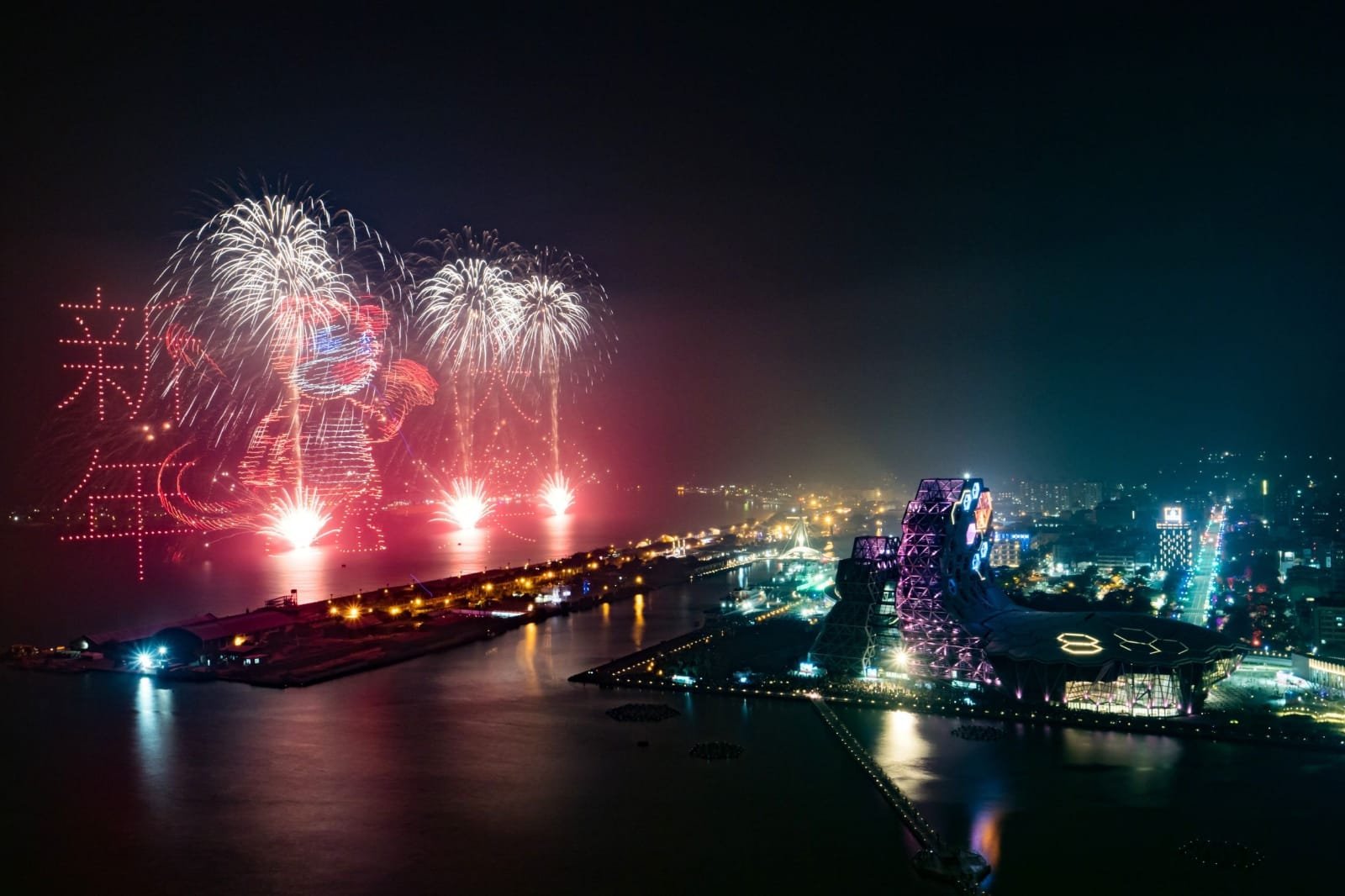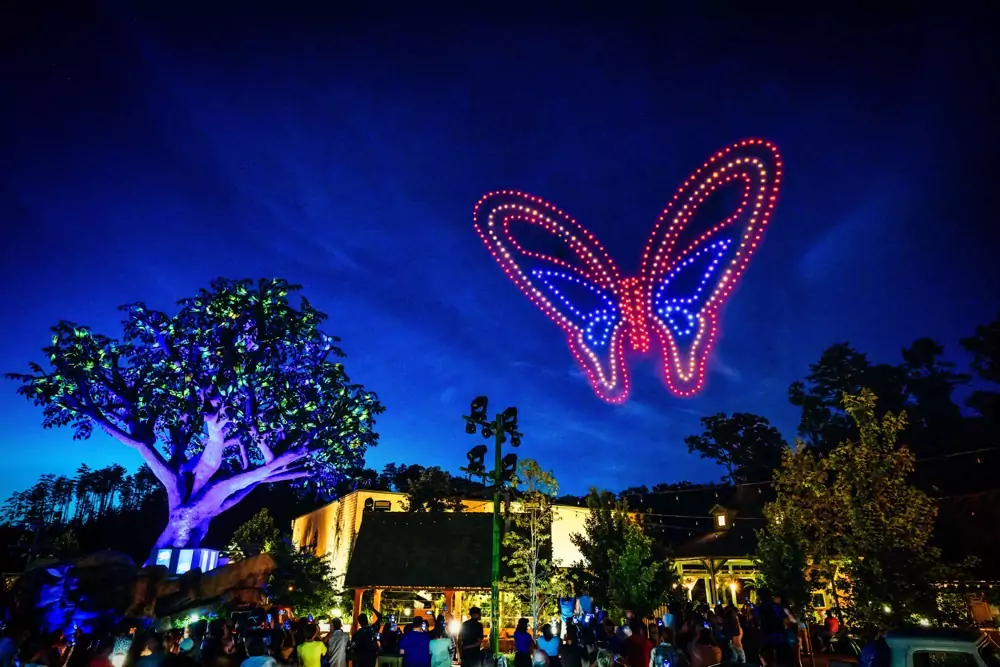intel | Drone Light Shows
Drone light shows are an innovative form of aerial entertainment, where hundreds or even thousands of drones synchronize their positions, movements, and colored LED lights to create mesmerizing visual displays in the sky. Often accompanied by music and fireworks, these shows are a unique blend of cutting-edge technology and creativity, allowing massive, three-dimensional shapes to come to life and captivate audiences.
To give you a sense of scale, the Tiger God in our 2022 show for the Taiwan Lantern Festival consisted of 1,500 drones and spanned over 150 meters.
From 2021-2022, I worked as a Creative Director for Intel Drone Light Shows, joining a team known worldwide for pushing the limits of drone light shows.

Design for Scale
Designing large-scale drone formations is a highly complex and intricate process that requires careful consideration of a wide range of factors. Equipped with cutting-edge hardware and integrated software, designing artwork at such colossal sizes demands both creative and technical thinking to understand the medium, leverage its strengths, and devise innovative solutions to realize client visions through an iterative design process.
I wore many hats during my time at Intel, from Creative Director, 3D artist, animator, storyteller… I was involved from concept development all the way to show execution. The process would start with client pitches, where we would discuss their ideas for the show, and I would look to narrow in on a few ‘wow’ moments to elevate important aspects and/or iconography of the brand/event/etc. I created previsualization renders and animations of show moments to sell potential clients, from high profile sports events to international independence day celebrations, product launches, advertisements, movies, and more.
While it’s quick work to put together a mockup render or animation with Blender and Photoshop like the one below, designing assets to be show-ready gets a bit more complicated.
Concept Development
Once a client was onboard, we would work with them to build a storyboard for the show— a process of communicating the possibilities of the technology, managing expectations, delivering mockups, integrating stakeholder feedback, and progressively refining the show with layers of detail and synchronizing with audio. Creative development is also informed and sometimes must be changed to accommodate technical details from site surveys, which can affect the size of the show’s boundary, windspeed at the venue that determines how fast the drones can fly, local radio channel traffic that affects how close they are allowed to fly to each other, etc.— we’ll touch more on technical matters later…
Shows are often composed of a collection of animated moments, connected elegantly through procedurally generated flight paths that optimize for collision avoidance. Treatment of the transitions is key to set the flow of the show, whether to build anticipation for an epic reveal, or as an artful treatment of light, color, and motion that dazzles in its own right.
Humans have looked to the constellations and told stories for millennia… these new constellations move, rearrange, interact, and change colors, synchronized to music. Within each scene, drone choreography can make massive characters and objects come alive. Motion can be created through both drone movement and through changing the brightness and color of their LED lights, allowing for frame by frame animations, layer masking, shading, and more. Whether it’s a butterfly flapping its wings, or even something as simple as a character blinking, finding clever ways to imbue a scene with intrigue and action can add significant impact.
Using drones efficiently to maximize visual impact is especially important when working with less than 500 drones. Dollywood approached Intel Drone Light Shows to create a double length 200-drone show, one 400-drone butterfly as the fleets overlap for 1 minute. In order to create compelling moments with 200 drones, the designs need to be clean and iconic, with dynamic use of synchronized lighting. Pictured below is a compiled storyboard that I made as creative lead on the recurring drone show at Dollywood’s Summer Celebration in 2021.
Technical Considerations
When creating drone shows, design constraints often present unique creative challenges that require elegant solutions or clever compromises. The first rule of drone shows is don’t make them crash into each other and fall down. So, when creating a formation of drones, we need to put enough space between all of them to account for gusts, and also to give the drones a safety buffer when they decelerate as they arrive in formation. The density of the drone spacing also comes into play when avoiding any intersecting paths as the drones transition between formations. This minimum spacing constraint gives us a sort of volumetric resolution to work around.
The speed of the drones is also crucial, as it affects the overall choreography and timing of the show. Considering the high level shape of different show moments is important when designing the storyboard of the show. In order to maximize the amount of time we can be displaying designed content, we want to minimize the amount of time that they are transitioning between formations. Since drones still fly with finite speed and acceleration, to minimize transition times, we want to align the general shape and orientation of the formations as much as possible, keeping in mind dense areas of drones. Since we’re working at such large scales, each moment needs to be considered in the overall context and flow of the show— considering interwoven interdependencies that can have cascading effects.
One of my favorite things to do as a creative technologist is to apply an emergent medium/technology in a new way that fully realizes its unique capabilities to make storytelling more impactful, opening up new ways to surprise and delight audiences. In the case of drones, they are unique in their capacity to convey animated 3-dimensional structures at a massive scale. The following segment (shown at 2x speed) shows how I applied some of the topics we’ve covered so far.
The country of Bangladesh hired us to create a drone show to celebrate the completion of a new bridge and commuter train connecting an important nearby region to their capital city, Dhaka. Additionally, the client wanted to celebrate starting construction on a $12b development creating a new business district along with a beautiful 3-pillared skyscraper, Legacy Tower.
The sequence starts with a portrait of Sheik Hasina, and important figure in Bangladesh. Her clothing flutters in the wind, and she blinks while looking down at the audience, reminiscent of a magical portrait from the world of Harry Potter. The drones disperse into space as the bridge coalesces together, and a subway travels through a tunnel inside it. Then the whole scene transforms to a zoomed in version of the subway car, which rolls to a stop, and passengers emerge from the inside. Finally, the epic skyscraper pillars are revealed vertically in their glory.
Integrating these secondary and tertiary animation layers provides the scene with intrigue and nuance that enrich the audience experience.

In 2022, Intel Drone Light Shows became the first successful acquisition exit to come out of Intel’s Emerging Growth and Incubation program, when it was purchased by an outside party to become Nova Sky Stories. With the change in ownership in flux, shows were no longer a top priority for the time being, at which point I transitioned to another team within Intel’s Incubator program, (a multi-camera array for immersive video capture, but we won’t get into that here).
My time working at Intel on drone light shows was a valuable learning experience in many ways. I was able to develop my aesthetic and technical skills in tandem, while also gaining experience leading creative development on high profile projects, working directly with large clients, often maneuvering through conflicting requests / feedback from multiple stakeholders throughout the process. It was truly rewarding to be a part of a team that created awe-inspiring shows for audiences worldwide. One of my personal favorite parts of the job is hearing a crowd collectively gasps, oohs, and aahs. By weaving modern technology into the tapestry of the night sky, we crafted our own constellations—ephemeral, yet dazzling—capturing the imagination and evoking a sense of wonder through story, art, and magic [aka advanced technology].
Oh ya one last thing— METADRONE!





